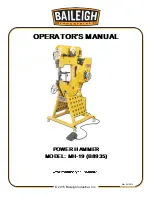
POWER TOOL USE AND CARE
1. Avoid accidental start-ups. Make sure the power switch is in the OFF position before connecting the plug to
a power source or carrying the tool.
2. Check power tool for damaged parts. Check for misalignment of moving parts, jamming, breakage, improper
mounting, or any other conditions that may affect the tool’s operation. Do not use the power tool if the switch
does not turn ON/OFF. Any part that is damaged should be properly repaired or replaced before use.
3. Do not force the tool to do a job for which it was not designed. Always use the correct tool/accessory for the
job and follow instructions to prevent a hazardous situation.
4. Never stand on the tool. Serious injury could occur if the tool is tipped over or if parts of the tool are unin-
tentionally contacted.
5. Remove adjustment tools. Always make sure all adjustment tools or wrenches are removed from the tool
before turning on the power tool.
6. Keep guards in place and in working order before operating the tool. All protection and safety devices must
be in place after completing repair and maintenance procedures.
7. Never leave a running tool unattended. Do not leave the tool until it has come to a complete stop.
POWER TOOL MAINTENANCE
1. Always disconnect the power cord plug from the electrical outlet when making adjustments, changing parts,
or storing power tools. Such preventive safety measures reduce the risk of starting the power tool accidentally.
2. Maintain power tools properly. Safely store power tools out of the reach of children. Always keep tools clean
and in good working order. Follow instructions for lubricating and changing accessories.
SERVICING
Use only identical replacement parts. Use of any other part can cause personal injury and damage to the tool.
Only have your power tool serviced by a qualified repair person.
CALIFORNIA PROPOSITION 65 WARNING
Some dust created by power sanding, sawing, grinding, drilling, and other construction activities may contain
chemicals, including lead, known to the State of California to cause cancer, birth defects, or other reproductive
harm. Wash hands after handling.
Some examples of these chemicals are:
•
Lead from lead-based paints.
•
Crystalline silica from bricks, cement, and other masonry products.
•
Arsenic and chromium from chemically treated lumber.
Your risk from these exposures varies depending on how often you do this type of work. To reduce your ex-
posure to these chemicals, work in a well-ventilated area with approved safety equipment such as dust masks
specially designed to filter out microscopic particles.
GENERAL SAFETY RULES
5
Summary of Contents for 23114
Page 18: ...THANKS FOR REMEMBERING ...




































